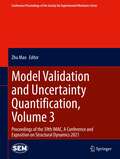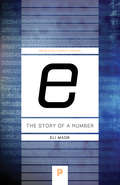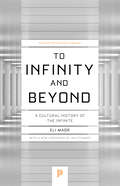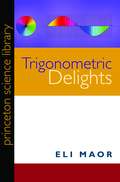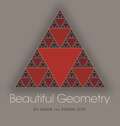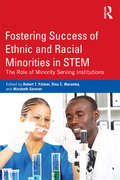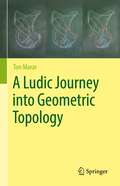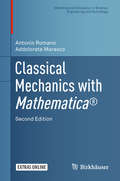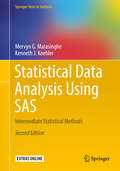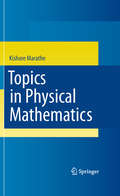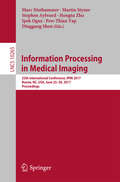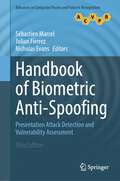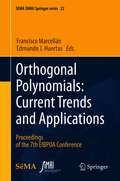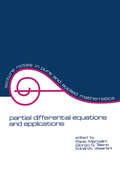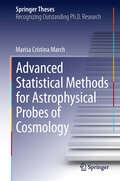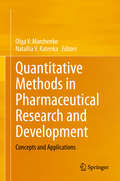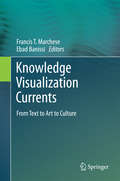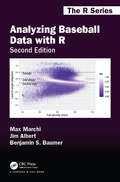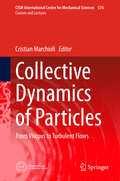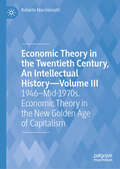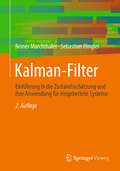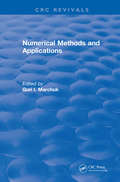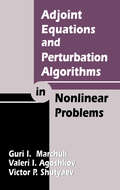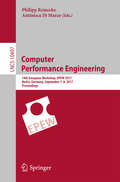- Table View
- List View
Model Validation and Uncertainty Quantification, Volume 3: Proceedings of the 39th IMAC, A Conference and Exposition on Structural Dynamics 2021 (Conference Proceedings of the Society for Experimental Mechanics Series)
by Zhu MaoModel Validation and Uncertainty Quantification, Volume 3: Proceedings of the 39th IMAC, A Conference and Exposition on Structural Dynamics, 2021, the third volume of nine from the Conference brings together contributions to this important area of research and engineering. The collection presents early findings and case studies on fundamental and applied aspects of Model Validation and Uncertainty Quantification, including papers on:Inverse Problems and Uncertainty QuantificationControlling UncertaintyValidation of Models for Operating EnvironmentsModel Validation & Uncertainty Quantification: Decision MakingUncertainty Quantification in Structural DynamicsUncertainty in Early Stage DesignComputational and Uncertainty Quantification Tools
"e": The Story of a Number
by Eli MaorThe interest earned on a bank account, the arrangement of seeds in a sunflower, and the shape of the Gateway Arch in St. Louis are all intimately connected with the mysterious number e. In this informal and engaging history, Eli Maor portrays the curious characters and the elegant mathematics that lie behind the number. Designed for a reader with only a modest mathematical background, this biography brings out the central importance of e to mathematics and illuminates a golden era in the age of science.
To Infinity and Beyond: A Cultural History of the Infinite
by Eli MaorTo Infinity and Beyond explores the idea of infinity in mathematics and art. <p><p>Eli Maor examines the role of infinity, as well as its cultural impact on the arts and sciences. He evokes the profound intellectual impact the infinite has exercised on the human mind—from the horror infiniti of the Greeks to the works of M. C. Escher; from the ornamental designs of the Moslems, to the sage Giordano Bruno, whose belief in an infinite universe led to his death at the hands of the Inquisition. But above all, the book describes the mathematician's fascination with infinity—a fascination mingled with puzzlement.
Trigonometric Delights
by Eli MaorTrigonometry has always been the black sheep of mathematics. It has a reputation as a dry and difficult subject, a glorified form of geometry complicated by tedious computation. In this book, Eli Maor draws on his remarkable talents as a guide to the world of numbers to dispel that view. Rejecting the usual arid descriptions of sine, cosine, and their trigonometric relatives, he brings the subject to life in a compelling blend of history, biography, and mathematics. He presents both a survey of the main elements of trigonometry and a unique account of its vital contribution to science and social development. Woven together in a tapestry of entertaining stories, scientific curiosities, and educational insights, the book more than lives up to the title Trigonometric Delights.Maor, whose previous books have demystified the concept of infinity and the unusual number "e," begins by examining the "proto-trigonometry" of the Egyptian pyramid builders. He shows how Greek astronomers developed the first true trigonometry. He traces the slow emergence of modern, analytical trigonometry, recounting its colorful origins in Renaissance Europe's quest for more accurate artillery, more precise clocks, and more pleasing musical instruments. Along the way, we see trigonometry at work in, for example, the struggle of the famous mapmaker Gerardus Mercator to represent the curved earth on a flat sheet of paper; we see how M. C. Escher used geometric progressions in his art; and we learn how the toy Spirograph uses epicycles and hypocycles.Maor also sketches the lives of some of the intriguing figures who have shaped four thousand years of trigonometric history. We meet, for instance, the Renaissance scholar Regiomontanus, who is rumored to have been poisoned for insulting a colleague, and Maria Agnesi, an eighteenth-century Italian genius who gave up mathematics to work with the poor--but not before she investigated a special curve that, due to mistranslation, bears the unfortunate name "the witch of Agnesi." The book is richly illustrated, including rare prints from the author's own collection. Trigonometric Delights will change forever our view of a once dreaded subject.
Beautiful Geometry
by Eli Maor Eugen JostAn exquisite visual celebration of the 2,500-year history of geometryIf you've ever thought that mathematics and art don't mix, this stunning visual history of geometry will change your mind. As much a work of art as a book about mathematics, Beautiful Geometry presents more than sixty exquisite color plates illustrating a wide range of geometric patterns and theorems, accompanied by brief accounts of the fascinating history and people behind each. With artwork by Swiss artist Eugen Jost and text by math historian Eli Maor, this unique celebration of geometry covers numerous subjects, from straightedge-and-compass constructions to intriguing configurations involving infinity. The result is a delightful and informative illustrated tour through the 2,500-year-old history of one of the most important branches of mathematics.
Fostering Success of Ethnic and Racial Minorities in STEM: The Role of Minority Serving Institutions
by Dina C. Maramba Marybeth Gasman Robert T. PalmerTo maintain competitiveness in the global economy, United States policymakers and national leaders are increasing their attention to producing workers skilled in science, technology, engineering, and mathematics (STEM). Given the growing minority population in the country, it is critical that higher education policies, pedagogies, climates, and initiatives are effective in promoting racial and ethnic minority students’ educational attainment in STEM. Minority Serving Institutions (MSIs) have shown efficacy in facilitating the success of racial and ethnic minority students in STEM and are collectively responsible for producing nearly one-third of the nation’s minority STEM graduates. In Fostering Success of Ethnic and Racial Minorities in STEM, well-known contributors share salient institutional characteristics, unique aspects of climate, pedagogy, and programmatic initiatives at MSIs that are instrumental in enhancing the success of racial and ethnic minority students in STEM education. This book provides recommendations on institutional practice, policy, and lessons that any institution can use on their campus to foster better retention and persistence among minority students. Higher Education leaders and administrators interested in encouraging achievement among racial and ethnic minority students in STEM education will find this book a welcomed and timely addition to the discourse on promoting minority student success.
A Ludic Journey into Geometric Topology
by Ton MararThis book draws on elements from everyday life, architecture, and the arts to provide the reader with elementary notions of geometric topology. Pac Man, subway maps, and architectural blueprints are the starting point for exploring how knowledge about geometry and, more specifically, topology has been consolidated over time, offering a learning journey that is both dense and enjoyable. The text begins with a discussion of mathematical models, moving on to Platonic and Keplerian theories that explain the Cosmos. Geometry from Felix Klein's point of view is then presented, paving the way to an introduction to topology. The final chapters present the concepts of closed, orientable, and non-orientable surfaces, as well as hypersurface models. Adopting a style that is both rigorous and accessible, this book will appeal to a broad audience, from curious students and researchers in various areas of knowledge to everyone who feels instigated by the power of mathematics in representing our world - and beyond.
Classical Mechanics with Mathematica® (Modeling and Simulation in Science, Engineering and Technology #0)
by Addolorata Marasco Antonio RomanoThis textbook takes a broad yet thorough approach to mechanics, aimed at bridging the gap between classical analytic and modern differential geometric approaches to the subject. Developed by the authors from over 30 years of teaching experience, the presentation is designed to give students an overview of the many different models used through the history of the field—from Newton to Hamilton—while also painting a clear picture of the most modern developments. The text is organized into two parts. The first focuses on developing the mathematical framework of linear algebra and differential geometry necessary for the remainder of the book. Topics covered include tensor algebra, Euclidean and symplectic vector spaces, differential manifolds, and absolute differential calculus. The second part of the book applies these topics to kinematics, rigid body dynamics, Lagrangian and Hamiltonian dynamics, Hamilton–Jacobi theory, completely integrable systems, statistical mechanics of equilibrium, and impulsive dynamics, among others. This new edition has been completely revised and updated and now includes almost 200 exercises, as well as new chapters on celestial mechanics, one-dimensional continuous systems, and variational calculus with applications. Several Mathematica® notebooks are available to download that will further aid students in their understanding of some of the more difficult material. Unique in its scope of coverage and method of approach, Classical Mechanics with Mathematica® will be useful resource for graduate students and advanced undergraduates in applied mathematics and physics who hope to gain a deeper understanding of mechanics.
Statistical Data Analysis Using SAS: Intermediate Statistical Methods (Springer Texts in Statistics)
by Mervyn G. Marasinghe Kenneth J. KoehlerThe aim of this textbook (previously titled SAS for Data Analytics) is to teach the use of SAS for statistical analysis of data for advanced undergraduate and graduate students in statistics, data science, and disciplines involving analyzing data.The book begins with an introduction beyond the basics of SAS, illustrated with non-trivial, real-world, worked examples. It proceeds to SAS programming and applications, SAS graphics, statistical analysis of regression models, analysis of variance models, analysis of variance with random and mixed effects models, and then takes the discussion beyond regression and analysis of variance to conclude.Pedagogically, the authors introduce theory and methodological basis topic by topic, present a problem as an application, followed by a SAS analysis of the data provided and a discussion of results. The text focuses on applied statistical problems and methods. Key features include: end of chapter exercises, downloadable SAS code and data sets, and advanced material suitable for a second course in applied statistics with every method explained using SAS analysis to illustrate a real-world problem.New to this edition:• Covers SAS v9.2 and incorporates new commands• Uses SAS ODS (output delivery system) for reproduction of tables and graphics output• Presents new commands needed to produce ODS output• All chapters rewritten for clarity• New and updated examples throughout• All SAS outputs are new and updated, including graphics• More exercises and problems• Completely new chapter on analysis of nonlinear and generalized linear models• Completely new appendixMervyn G. Marasinghe, PhD, is Associate Professor Emeritus of Statistics at Iowa State University, where he has taught courses in statistical methods and statistical computing.Kenneth J. Koehler, PhD, is University Professor of Statistics at Iowa State University, where he teaches courses in statistical methodology at both graduate and undergraduate levels and primarily uses SAS to supplement his teaching.
Topics in Physical Mathematics
by Kishore MaratheAs many readers will know, the 20th century was a time when the fields of mathematics and the sciences were seen as two separate entities. Caused by the rapid growth of the physical sciences and an increasing abstraction in mathematical research, each party, physicists and mathematicians alike, suffered a misconception; not only of the opposition's theoretical underpinning, but of how the two subjects could be intertwined and effectively utilized. One sub-discipline that played a part in the union of the two subjects is Theoretical Physics. Breaking it down further came the fundamental theories, Relativity and Quantum theory, and later on Yang-Mills theory. Other areas to emerge in this area are those derived from the works of Donaldson, Chern-Simons, Floer-Fukaya, and Seiberg-Witten. Aimed at a wide audience, Physical Topics in Mathematics demonstrates how various physical theories have played a crucial role in the developments of Mathematics and in particular, Geometric Topology. Issues are studied in great detail, and the book steadfastly covers the background of both Mathematics and Theoretical Physics in an effort to bring the reader to a deeper understanding of their interaction. Whilst the world of Theoretical Physics and Mathematics is boundless; it is not the intention of this book to cover its enormity. Instead, it seeks to lead the reader through the world of Physical Mathematics; leaving them with a choice of which realm they wish to visit next.
Information Processing in Medical Imaging: 25th International Conference, IPMI 2017, Boone, NC, USA, June 25-30, 2017, Proceedings (Lecture Notes in Computer Science #10265)
by Marc Niethammer, Martin Styner, Stephen Aylward, Hongtu Zhu, Ipek Oguz, Pew-Thian Yap and Dinggang ShenThis book constitutes the proceedings of the 25th International Conference on Information Processing in Medical Imaging, IPMI 2017, held at the Appalachian State University, Boon, NC, USA, in June 2017. The 53 full papers presented in this volume were carefully reviewed and selected from 147 submissions. They were organized in topical sections named: analysis on manifolds; shape analysis; disease diagnosis/progression; brain networks an connectivity; diffusion imaging; quantitative imaging; imaging genomics; image registration; segmentation; general image analysis.
Handbook of Biometric Anti-Spoofing: Presentation Attack Detection and Vulnerability Assessment (Advances in Computer Vision and Pattern Recognition)
by Sébastien Marcel Julian Fierrez Nicholas EvansThe third edition of this authoritative and comprehensive handbook is the definitive work on the current state of the art of Biometric Presentation Attack Detection (PAD) – also known as Biometric Anti-Spoofing. Building on the success of the previous editions, this thoroughly updated third edition has been considerably revised to provide even greater coverage of PAD methods, spanning biometrics systems based on face, fingerprint, iris, voice, vein, and signature recognition. New material is also included on major PAD competitions, important databases for research, and on the impact of recent international legislation. Valuable insights are supplied by a selection of leading experts in the field, complete with results from reproducible research, supported by source code and further information available at an associated website.Topics and features: reviews the latest developments in PAD for fingerprint biometrics, covering recent technologies like Vision Transformers, and review of competition series; examines methods for PAD in iris recognition systems, the use of pupil size measurement or multiple spectra for this purpose; discusses advancements in PAD methods for face recognition-based biometrics, such as recent progress on detection of 3D facial masks and the use of multiple spectra with Deep Neural Networks; presents an analysis of PAD for automatic speaker recognition (ASV), including a study of the generalization to unseen attacks; describes the results yielded by key competitions on fingerprint liveness detection, iris liveness detection, and face anti-spoofing; provides analyses of PAD in finger-vein recognition, in signature biometrics, and in mobile biometrics; includes coverage of international standards in PAD and legal aspects of image manipulations like morphing.This text/reference is essential reading for anyone involved in biometric identity verification, be they students, researchers, practitioners, engineers, or technology consultants. Those new to the field will also benefit from a number of introductory chapters, outlining the basics for the most important biometrics.This text/reference is essential reading for anyone involved in biometric identity verification, be they students, researchers, practitioners, engineers, or technology consultants. Those new to the field will also benefit from a number of introductory chapters, outlining the basics for the most important biometrics.
Orthogonal Polynomials: Proceedings of the 7th EIBPOA Conference (SEMA SIMAI Springer Series #22)
by Francisco Marcellán Edmundo J. HuertasThe present volume contains the Proceedings of the Seventh Iberoamerican Workshop in Orthogonal Polynomials and Applications (EIBPOA, which stands for Encuentros Iberoamericanos de Polinomios Ortogonales y Aplicaciones, in Spanish), held at the Universidad Carlos III de Madrid, Leganés, Spain, from July 3 to July 6, 2018.These meetings were mainly focused to encourage research in the fields of approximation theory, special functions, orthogonal polynomials and their applications among graduate students as well as young researchers from Latin America, Spain and Portugal. The presentation of the state of the art as well as some recent trends constitute the aim of the lectures delivered in the EIBPOA by worldwide recognized researchers in the above fields.In this volume, several topics on the theory of polynomials orthogonal with respect to different inner products are analyzed, both from an introductory point of view for a wide spectrum of readers without an expertise in the area, as well as the emphasis on their applications in topics as integrable systems, random matrices, numerical methods in differential and partial differential equations, coding theory, and signal theory, among others.
partial differential equations and applications: Collected Papers in Honor of Carlo Pucci (Lecture Notes in Pure and Applied Mathematics #177)
by Paolo Marcellini Giorgio G. Talenti Edoardo VesentiniWritten as a tribute to the mathematician Carlo Pucci on the occasion of his 70th birthday, this is a collection of authoritative contributions from over 45 internationally acclaimed experts in the field of partial differential equations. Papers discuss a variety of topics such as problems where a partial differential equation is coupled with unfavourable boundary or initial conditions, and boundary value problems for partial differential equations of elliptic type.
Advanced Statistical Methods for Astrophysical Probes of Cosmology (Springer Theses)
by Marisa Cristina MarchThis thesis explores advanced Bayesian statistical methods for extracting key information for cosmological model selection, parameter inference and forecasting from astrophysical observations. Bayesian model selection provides a measure of how good models in a set are relative to each other - but what if the best model is missing and not included in the set? Bayesian Doubt is an approach which addresses this problem and seeks to deliver an absolute rather than a relative measure of how good a model is. Supernovae type Ia were the first astrophysical observations to indicate the late time acceleration of the Universe - this work presents a detailed Bayesian Hierarchical Model to infer the cosmological parameters (in particular dark energy) from observations of these supernovae type Ia.
Quantitative Methods in Pharmaceutical Research and Development: Concepts and Applications
by Olga V. Marchenko Natallia V. KatenkaThis contributed volume presents an overview of concepts, methods, and applications used in several quantitative areas of drug research, development, and marketing. Chapters bring together the theories and applications of various disciplines, allowing readers to learn more about quantitative fields, and to better recognize the differences between them. Because it provides a thorough overview, this will serve as a self-contained resource for readers interested in the pharmaceutical industry, and the quantitative methods that serve as its foundation. Specific disciplines covered include:BiostatisticsPharmacometricsGenomicsBioinformaticsPharmacoepidemiologyCommercial analyticsOperational analyticsQuantitative Methods in Pharmaceutical Research and Development is ideal for undergraduate students interested in learning about real-world applications of quantitative methods, and the potential career options open to them. It will also be of interest to experts working in these areas.
Knowledge Visualization Currents
by Francis T. Marchese Ebad BanissiThis text reviews the evolution of the field of visualization, providing innovative examples from various disciplines, highlighting the important role that visualization plays in extracting and organizing the concepts found in complex data. Features: presents a thorough introduction to the discipline of knowledge visualization, its current state of affairs and possible future developments; examines how tables have been used for information visualization in historical textual documents; discusses the application of visualization techniques for knowledge transfer in business relationships, and for the linguistic exploration and analysis of sensory descriptions; investigates the use of visualization to understand orchestral music scores, the optical theory behind Renaissance art, and to assist in the reconstruction of an historic church; describes immersive 360 degree stereographic visualization, knowledge-embedded embodied interaction, and a novel methodology for the analysis of architectural forms.
Analyzing Baseball Data with R, Second Edition (Chapman & Hall/CRC The R Series #14)
by Max Marchi Jim Albert Benjamin S. BaumerAnalyzing Baseball Data with R Second Edition introduces R to sabermetricians, baseball enthusiasts, and students interested in exploring the richness of baseball data. It equips you with the necessary skills and software tools to perform all the analysis steps, from importing the data to transforming them into an appropriate format to visualizing the data via graphs to performing a statistical analysis. The authors first present an overview of publicly available baseball datasets and a gentle introduction to the type of data structures and exploratory and data management capabilities of R. They also cover the ggplot2 graphics functions and employ a tidyverse-friendly workflow throughout. Much of the book illustrates the use of R through popular sabermetrics topics, including the Pythagorean formula, runs expectancy, catcher framing, career trajectories, simulation of games and seasons, patterns of streaky behavior of players, and launch angles and exit velocities. All the datasets and R code used in the text are available online. New to the second edition are a systematic adoption of the tidyverse and incorporation of Statcast player tracking data (made available by Baseball Savant). All code from the first edition has been revised according to the principles of the tidyverse. Tidyverse packages, including dplyr, ggplot2, tidyr, purrr, and broom are emphasized throughout the book. Two entirely new chapters are made possible by the availability of Statcast data: one explores the notion of catcher framing ability, and the other uses launch angle and exit velocity to estimate the probability of a home run. Through the book’s various examples, you will learn about modern sabermetrics and how to conduct your own baseball analyses. Max Marchi is a Baseball Analytics Analyst for the Cleveland Indians. He was a regular contributor to The Hardball Times and Baseball Prospectus websites and previously consulted for other MLB clubs. Jim Albert is a Distinguished University Professor of statistics at Bowling Green State University. He has authored or coauthored several books including Curve Ball and Visualizing Baseball and was the editor of the Journal of Quantitative Analysis of Sports. Ben Baumer is an assistant professor of statistical & data sciences at Smith College. Previously a statistical analyst for the New York Mets, he is a co-author of The Sabermetric Revolution and Modern Data Science with R.
Collective Dynamics of Particles: From Viscous to Turbulent Flows (CISM International Centre for Mechanical Sciences #576)
by Cristian MarchioliThe book surveys the state-of-the-art methods that are currently available to model and simulate the presence of rigid particles in a fluid flow. For particles that are very small relative to the characteristic flow scales and move without interaction with other particles, effective equations of motion for particle tracking are formulated and applied (e.g. in gas-solid flows). For larger particles, for particles in liquid-solid flows and for particles that interact with each other or possibly modify the overall flow detailed model are presented. Special attention is given to the description of the approximate force coupling method (FCM) as a more general treatment for small particles, and derivations in the context of low Reynolds numbers for the particle motion as well as application at finite Reynolds numbers are provided. Other topics discussed in the book are the relation to higher resolution immersed boundary methods, possible extensions to non-spherical particles and examples of applications of such methods to dispersed multiphase flows.
Economic Theory in the Twentieth Century, An Intellectual History—Volume III: 1946–Mid-1970s. Economic Theory in the New Golden Age of Capitalism
by Roberto MarchionattiThis book, set out over four-volumes, provides a comprehensive history of economic thought in the 20th century. Special attention is given to the cultural and historical background behind the development of economic theories, the leading or the peripheral research communities and their interactions, and a critical appreciation and assessment of economic theories throughout these times.Volume III addresses economic theory in the period of the new golden age of capitalism, between the years from the end of the Second World War to the mid1970s, which saw the establishment of the new mainstream, in particular in its Harvard-MIT-Cowles version. It was the period of the pre-eminence of the Neoclassical Keynesian Synthesis—the theoretical core of the period’s dominant school of thought.This work provides a significant and original contribution to the history of economic thought and gives insight to the thinking of some of themajor international figures in economics. It will appeal to students, scholars and the more informed reader wishing to further their understanding of the history of the discipline.
Computational Models for Polydisperse Particulate and Multiphase Systems
by Daniele L. Marchisio Rodney O. FoxProviding a clear description of the theory of polydisperse multiphase flows, with emphasis on the mesoscale modelling approach and its relationship with microscale and macroscale models, this all-inclusive introduction is ideal whether you are working in industry or academia. Theory is linked to practice through discussions of key real-world cases (particle/droplet/bubble coalescence, break-up, nucleation, advection and diffusion and physical- and phase-space), providing valuable experience in simulating systems that can be applied to your own applications. Practical cases of QMOM, DQMOM, CQMOM, EQMOM and ECQMOM are also discussed and compared, as are realizable finite-volume methods. This provides the tools you need to use quadrature-based moment methods, choose from the many available options, and design high-order numerical methods that guarantee realizable moment sets. In addition to the numerous practical examples, MATLAB scripts for several algorithms are also provided, so you can apply the methods described to practical problems straight away.
Kalman-Filter: Einführung in die Zustandsschätzung und ihre Anwendung für eingebettete Systeme
by Reiner Marchthaler Sebastian DinglerDieses Lehrbuch befasst sich leicht verständlich mit der Theorie der Kalman-Filterung. Die Autoren geben damit eine Einführung in Kalman-Filter und deren Anwendung für eingebettete Systeme. Zusätzlich wird anhand konkreter Praxisbeispiele der Kalman-Filterentwurf demonstriert – Teilschritte werden im Buch ausführlich erläutert.Kalman-Filter sind die erste Wahl, um Störsignale auf den Sensorsignalen zu eliminieren. Dies ist von besonderer Bedeutung, da viele technische Systeme ihre prozessrelevanten Informationen über Sensoren gewinnen. Jeder Messwert eines Sensors weißt jedoch aufgrund verschiedener Ursachen einen Messfehler auf. Würde ein System nur auf Basis dieser ungenauen Sensorinformationen arbeiten, so wären viele Anwendungen, wie zum Beispiel ein Navigationssystem oder autonome arbeitende Systeme, nicht möglich.Das Buch ist geeignet für interessierte Bachelor- und Master-Studierende der Fachrichtungen Informatik, Maschinenbau, Elektrotechnik undMechatronik. Ebenso ist das Buch eine Hilfe für Ingenieure und Wissenschaftler, die ein Kalman-Filter z. B. für die Datenfusion oder die Schätzung unbekannter Größen in Echtzeitanwendungen einsetzen möchten.
Numerical Methods and Applications (CRC Press Revivals)
by Guri I. MarchukThis book presents new original numerical methods that have been developed to the stage of concrete algorithms and successfully applied to practical problems in mathematical physics. The book discusses new methods for solving stiff systems of ordinary differential equations, stiff elliptic problems encountered in problems of composite material mechanics, Navier-Stokes systems, and nonstationary problems with discontinuous data. These methods allow natural paralleling of algorithms and will find many applications in vector and parallel computers.
Adjoint Equations and Perturbation Algorithms in Nonlinear Problems
by Guri I. Marchuk Valeri I. Agoshkov Victor P. ShutyaevSparked by demands inherent to the mathematical study of pollution, intensive industry, global warming, and the biosphere, Adjoint Equations and Perturbation Algorithms in Nonlinear Problems is the first book ever to systematically present the theory of adjoint equations for nonlinear problems, as well as their application to perturbation algorithms. This new approach facilitates analysis of observational data, the application of adjoint equations to retrospective study of processes governed by imitation models, and the study of computer models themselves. Specifically, the book discusses: Principles for constructing adjoint operators in nonlinear problemsProperties of adjoint operators and solvability conditions for adjoint equationsPerturbation algorithms using the adjoint equations theory for nonlinear problems in transport theory, quasilinear motion, substance transfer, and nonlinear data assimilationKnown results on adjoint equations and perturbation algorithms in nonlinear problemsThis groundbreaking text contains some results that have no analogs in the scientific literature, opening unbounded possibilities in construction and application of adjoint equations to nonlinear problems of mathematical physics.
Computer Performance Engineering: 14th European Workshop, EPEW 2017, Berlin, Germany, September 7-8, 2017, Proceedings (Lecture Notes in Computer Science #10497)
by Antinisca Di Marco Philipp ReineckeThis book constitutes the refereed proceedings of the 14th European Workshop on Computer Performance Engineering, EPEW 2017, held in Berlin, Germany, in September 2017. The 18 papers presented together with the abstracts of two invited talks in this volume were carefully reviewed and selected from 30 submissions. The papers presented at the workshop reflect the diversity of modern performance engineering, with topics ranging from advances in Markov models; advances in quantitative analysis; model checking; and cyber-physical systems to performance, energy and security.
